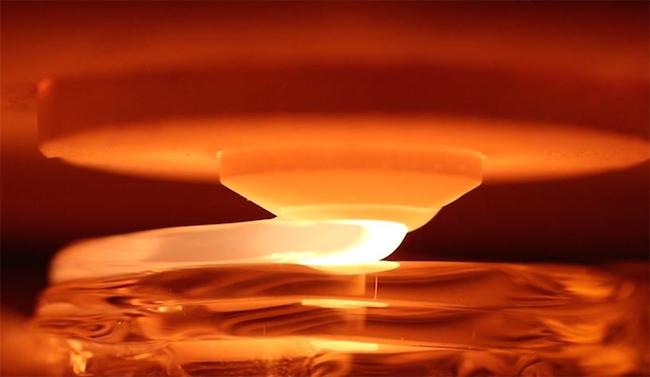In the two years since we started CFile we’ve watched 3D printing evolve at a breakneck speed. We’re impressed how artists and designers have kept pace with this new technology and we can’t wait to see what they do with this new piece of hardware.
Mediated Matter and MIT recently brought the science of 3D printing to an entirely new medium: glass. While typical plastics used in 3D printing melt at about 220 degrees, the glass printer operates at an audacious 2,100 degrees. Writing for Forbes, TJ McCue explains the process:

In an exceptionally detailed academic paper, Additive Manufacturing of Optically Transparent Glass, MIT Mediated Matter Lab authors (listed at end with link) explain how they built and conducted experiments with a glass 3-D printer using many of the same controllers and parts that existing Fused Deposition Modeling (FDM) printers use.
Working with molten glass is perhaps more dangerous than working with hot thermoplastics, but that is arguable, depending on your skill and attention to detail. Here’s how the Mediated Matter Research Group describes this 3-D printing glass project:
We present a fully functional material extrusion printer for optically transparent glass. The printer is comprised of scalable modular elements, able to operate at the high temperatures required to process glass from a molten state to an annealed product. We demonstrate a process enabling the construction of 3D parts as described by Computer Aided Design (CAD) models. Processing parameters such as temperature, which control glass viscosity, and flow rate, layer height and feed rate, can thus be adjusted to tailor printing to the desired component, its shape and its properties.
Like many academic teams, despite explaining things in a certain university-type language, they used off-the-shelf parts. They built this printer from many of the same parts used on fused deposition modeling printers (also called FDM and is one of the more common methods of 3-D printing): Arduino, RAMPS 1.4 Arduino shield, Open source slicing engine Repetier-Host, and Rhinoceros 5.0 CAD software, as well as a range of other bits and pieces that you or I could replicate.

The post linked above includes an embedded video and an in-depth analysis of the technology. One thing we noticed, though, (and this could be due to the relative newness of the field) is that 3D printing, with a few exceptions, looks to be of a type. We’ve seen many forms, be they in plastic or clay or glass, that display the corded horizontal lines that indicate we’re looking at a process that is more synthetic than traditional making. Hopefully as the science progresses someone will discover how to make these projects look more organic. At the rate the tech is moving, we have no doubt that we’ll see this develop soon.
Love contemporary ceramic art? Let us know in the comments.




Add your valued opinion to this post.